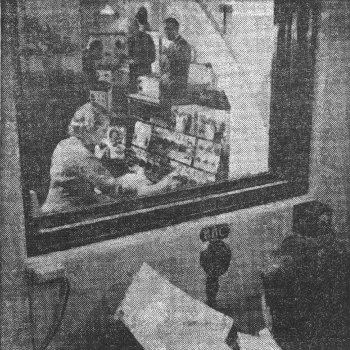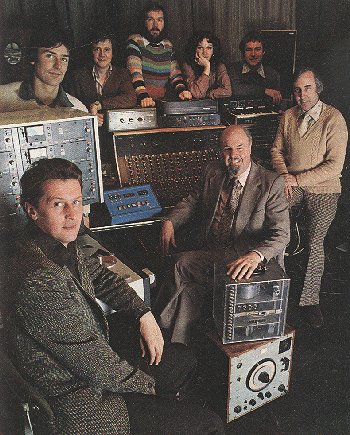 |
|
|
|||||||||||
![]()
MUSIC EX MACHINA
by Mick Brown
(no relation!)
First published in the Radio Times, 29-Mar-1979
The BBC Radiophonic Workshop is to be found in a quiet street in a London suburb: behind walls of unimposing grey, down long corridors and through swing doors which seem to mark the End of the World As We Know It. It is very unobtrusive, one suspects so as not to alarm the natives.
Within, the air reverberates to some half-heard electronic pulse. Unearthly sounds percolate from behind closed doors: monsters are being vaporised by ray-guns; blood courses melodiously down electronic arteries; the music of the spheres ebbs and fades. Here, machines whirr silently; digital messages flicker in stainless steel casings; harmonisers harmonise; oscillators oscillate; wires cross and technology spews forth art.
Outside the office of Desmond Briscoe, founder and director of the Radiophonic Workshop, someone has pinned an extract from Francis Bacon's The New Atlantis, published in 1627: "Wee have also Sound-houses, wher wee practise and demonstrate all Sounds and their Generation. Wee have harmonies which you have not, of Quarter-Sounds, and lesser Slides of Sounds. Diverse Instruments of Musick likewise to you unknowne, some sweeter than any you have ..."
Mr Briscoe smiles benignly at the prophetic vision of Bacon, as if they were friends. Clearly, here is someone to whom alien sounds would be as music to the ears; a scholarly man in a suit and open-toed sandals, with a domed, electronic-orb of a forehead which, one fancies, glows as he talks.
The idea of the New Atlantis still appeared to belong in books when the new convention of applied sound was first used in 1957 in Samuel Beckett's radio play, All That Fall. Before that, 'incidental music' had come from existing recordings. The growth in France of musique concrete - Is music made from naturalistic sounds-and of rudimentary electronic music in Germany engendered new possibilities of departing from musical convention and using different sounds as an impressionistic illustration for the spoken word. But it was the advent of the tape-recorder that made those possibilities manifest. 'Once you've got sound on tape it becomes an object,' says Mr Briscoe. 'You can handle it, cut it up, stretch it, play it backwards. You have the means to tailor sound to the length and mood of a programme. You have the beginnings of something exciting.'
 The Radiophonic Workshop was inaugurated in 1958, with a budget of £2,000,
Mr Briscoe and two colleagues, the first tape-machines ever to be seen in the
BBC, a wartime mixing desk acquired from the Albert Hall and a collection of
bottles brushes, saucepan-lids and watering-cans - and musical instruments -
from which the raw material of sound could be created. In its early years the
Workshop's activities were confined principally to radio: experimental drama and
'radiophonic poems', created to challenge the possibilities of the new craft. By
1963 the techniques of applied sound were sophisticated enough to produce what
remains arguably the Workshop's most famous piece: the theme for-Dr Who. With
the British public being fed unearthly sounds at teatime, the New Atlantis
appeared to have finally arrived with a vengeance.
The Radiophonic Workshop was inaugurated in 1958, with a budget of £2,000,
Mr Briscoe and two colleagues, the first tape-machines ever to be seen in the
BBC, a wartime mixing desk acquired from the Albert Hall and a collection of
bottles brushes, saucepan-lids and watering-cans - and musical instruments -
from which the raw material of sound could be created. In its early years the
Workshop's activities were confined principally to radio: experimental drama and
'radiophonic poems', created to challenge the possibilities of the new craft. By
1963 the techniques of applied sound were sophisticated enough to produce what
remains arguably the Workshop's most famous piece: the theme for-Dr Who. With
the British public being fed unearthly sounds at teatime, the New Atlantis
appeared to have finally arrived with a vengeance.
The Dr. Who theme took two weeks to manufacture: a laborious and painstaking process of taping, chopping, changing and reassembling note by note. To create it now would take only a matter of days. The development of the synthesiser-capable of producing and modifying an infinite range of sounds - has transformed the techniques of the Workshop, bringing with it a panoply of futuristic hardware, and a vocabulary to match: the ARP Odyssey and Avatar; Delaware Synthi 100; EMS Vocoder, with squelch switch.
Last year the Workshop contributed to more than 300 BBC programmes: electronic illustrations for school and Open University broadcasts; signature tunes; local radio identity jingles; special effects for programmes like Dr Who and Blake's Seven; the theme and incidental music for The Body in Question. The Workshop produces its own albums and its unique facilities allow its creative staff the time and resources to devise their own programmes like the rock-opera Rockoco by Paddy Kingsland [which will be] broadcast on Good Friday [1979].
There are six producers attached to the Workshop, essentially practical people, says Mr Briscoe; not intellectuals in the accepted sense of the word. 'An innate creativity; that is the prime thing. A light in the eye; throw an idea at them and they should hear a sound in their head to match.' Special effects are largely a question expertise: experience tells you that the sound of of a door gliding open in the 25th century - to mask the real sound of studio-hands heaving it to and fro in the 20th - can be easily fabricated by an oscillator, controlled by a lower oscillator, put through an envelope shaper with a trapezoid on the controlling oscillator. Anyone could do it. Well, almost anyone ... but most work requires a high degree of interpretative skill; to divine exactly what programme producers mean when they ask for 'radiophonic silence', to understand the intention of a programme and how best to complement and enhance an image with a sound or even use sound to suggest an emotional charge the image itself is unable to convey.
 |
Sounding out the future from a studio in
the unlikely setting of a London suburb: The Radiophonic Workshop's tem
of producers, gathered around what looks like the control desk of Dr.
Who's 'Tardis' - the Workshop's stereo mixing desk with (centre) an
early scanner and the 21 year old wobbulator used in the original
recording of the good Doctor's time capsule taking off.
Back row (left to right): John Downer, Peter Howell, Roger Limb, Elizabeth Parker, Paddy Kingsland. Front row: Brian Hodgson, Desmond Briscoe, Dick Mills |
An understanding of how and why certain sounds have the effect they do is inherent in the creative process. On television, in particular, incidentaal sound often works subliminally; you would be unaware of its contribution to the total viewing experience unless you turned off the volume. But to suggest that the Radiophonic Workshop creates sounds with specific psychological effects in mind does rather make it sound as if they're in the business of brainwashing, says Mr. Briscoe, electronic orb glowing in momentary irritation. 'Certainly we are very aware of the programme we're creating the sound for, and the purpose of the programme. It is functional music; it's got a job to do, so you can get specific results rather better than if you simply set out to make electronic music for entertainment.'
As yet the psychology of incidental music is still more a matter of instinct than science, although certain ways of manipulating sound can be seen to have predictable effects. The use of rhythm to quicken the pulse rate is the most fundamental example; the high ' sustained note to induce a momentary feeling of anxiety or suspense is another.
The very nature of electronic music-its tendency to sound 'dehumanised'- can be alienating or unsettling in itself. More orthodox instrumentation is often used in a piece which needs to make what Desmond Briscoe calls 'a direct appeal ' to the listener. 'Familiarity is a great help in accepting and understanding different types of music. Children will simply accept sound for what it is. But when there are no familiar terms of reference, no element of predictability - the mind doesn't know where the music is going to next - then it is likely to have a jarring effect. But by using the traditional components of melody, harmony or rhythm it is possible to make electronic music that has immediate appeal.'
Even where these traditional components are absent the creation and manipulation of electronic sound is still very much a human skill. No matter how alien a sound effect may sound to the casual ear, it bears the signature of its creator in its composition. Individual technique - the element of performance either in programming the sound or treating the tape - is the human fingerprint on the electronic circuit. In this respect the distinction between creating 'sound' and creating 'music' becomes hazy. The sound-effects montage of the Tardis taking off, for example, recorded in 1962, was 'scored' in much the same way as a conventional piece of music, all though the technique used to create it - scraping keys down piano strings and reversing, cutting and otherwise treating miles and miles of tape - was far from being conventional.
Sophisticated technology has largely obviated the need for formal musical training for producers, like Peter Howell, who scored The Body in Question. 'Now you can sit down with a tape-machine, just like an artist sits down with a brush and canvas, and paint yourself sound or music -and there's really no difference. What is satisfying is to get artistic results from brute machinery: to start off with something that's basically a load of wheels, a maze of electronic circuitry, and use that to convey human qualities.'
The synthesiser has broadened the range of sounds available to a producer to a degree undreamt of 20 years ago, but, versatile as it is, there are still certain qualities of sound that don't fall within its compass. Dick Mills, who for the last six years has been responsible for the Dr Who special effects, still finds there is nothing quite like the rustle of used tape or the simple expedient of a sink plunger and a bucket of mud to suggest something unmentionable lurking in the growth or festering in a swamp.
No matter how sophisticated technology becomes Mr. Briscoe believes, it will never usurp the need for human resourcefulness or technique. 'Music composed by computers is fine for other computers to listen to, but it doesn't do much for people.' he says. 'We are essentially concerned with programmes about people, for people. Without equipment we could never have done anything, but all the equipment in the world won't produce a single note of music or a worthwhile thing to listen to without people.' Mr Briscoe's electronic orb seems to take on a distinctly earthly hue. The sound of monsters being vaporised by ray-guns gives way to a human chuckle. One hears the sound of one's own footsteps above the half-heard electronic pulse as you pad down the long corridors and step into the damp anonymity of London suburbia feeling curiously comforted...
The History of the
Radiophonic Workshop | "The impossible we do
immediately..."
Concrete Mixers | Discography
Pansie Cola Space Station: 'Concrete for the Masses'
|